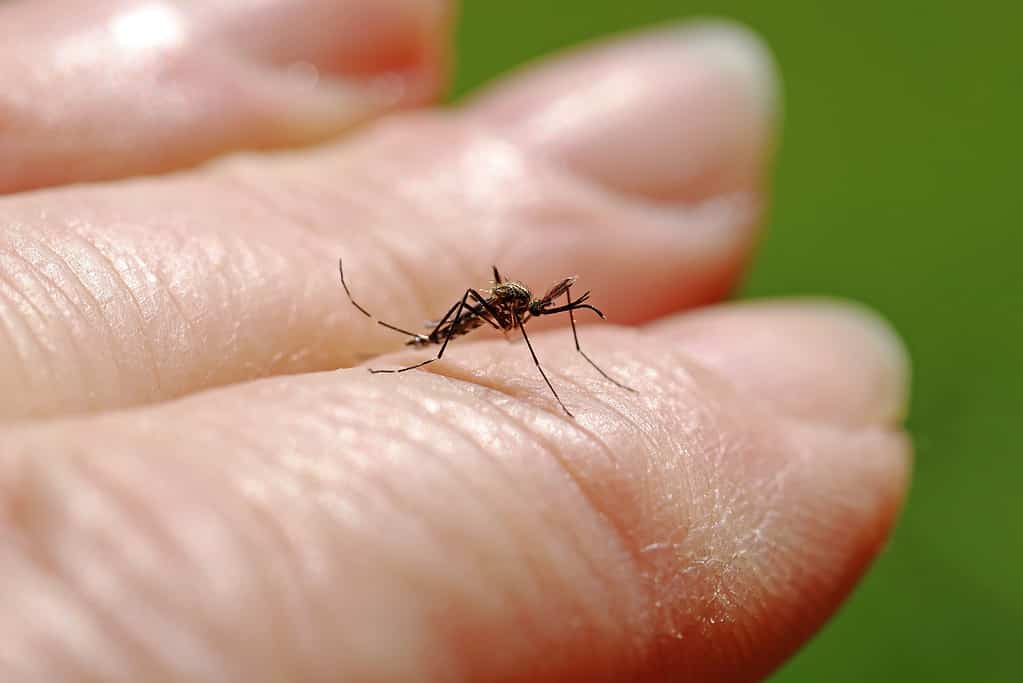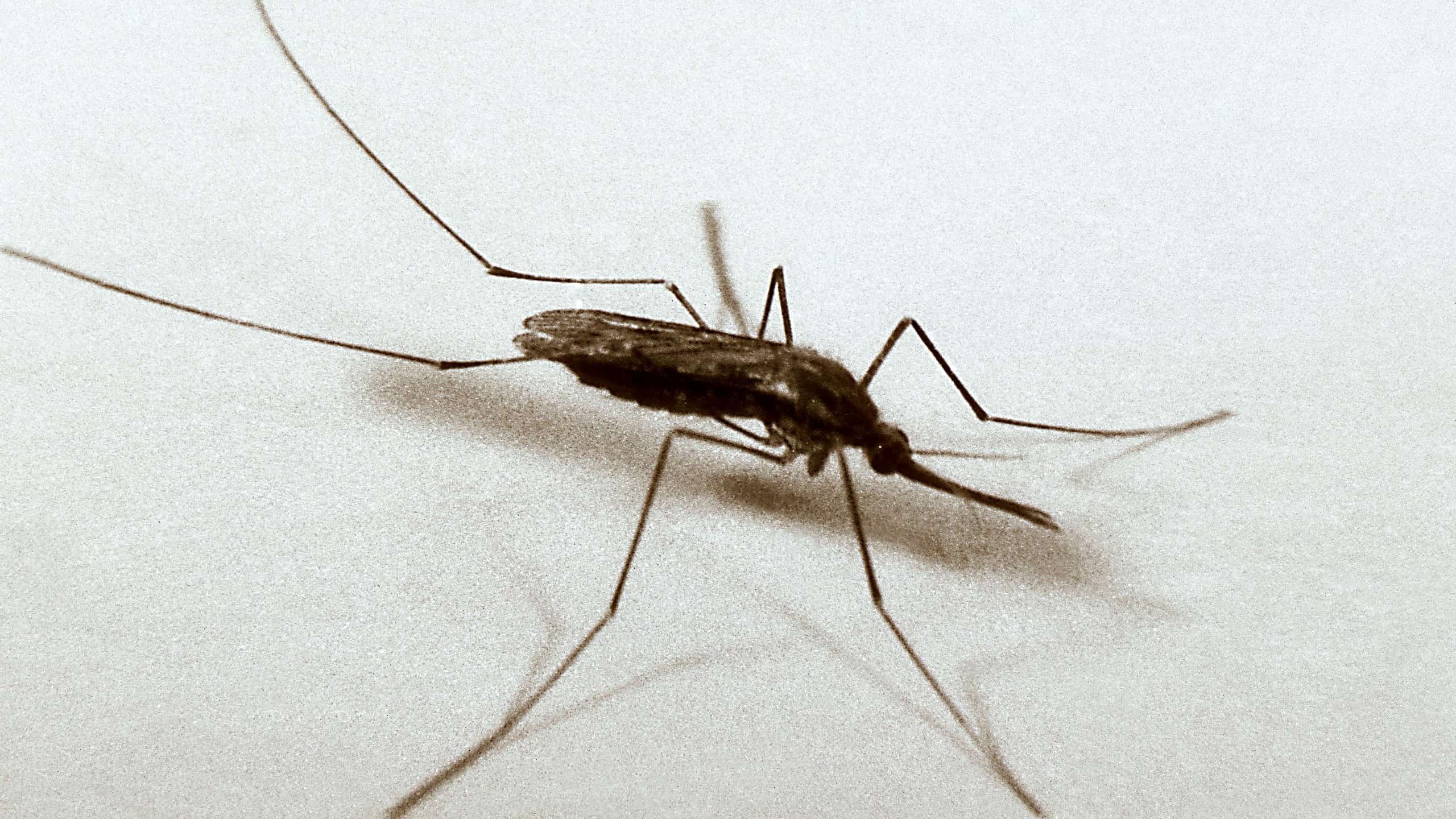When the weather is nice, it’s lovely to get outside and make the most of it. From beach days to camping trips, getting outside is a satisfying experience.
However, if there’s one thing that can turn a fun summer night into an annoying event, it’s getting eaten alive by mosquitoes. Mosquitoes are present all over the world. There’s only one country on Earth that has no mosquitoes at all: Iceland.
Chances are, you’re in one of the countries where mosquitoes are around every other corner. You’ve probably tried all sorts of measures to mitigate mosquito bites. Watches, spray, soap, candles… there is a neverending list of repellants. But did you know the color you’re wearing could make a difference?

These pesky bugs can cause annoying bites and scratches, or worse. Mosquitoes are known carriers of malaria.
©iStock.com/JPTis2016
It’s true. Mosquitoes are more attracted to some colors than others. The University of Washington has done a lot of research to discover associations between mosquito bites and color. So, which colors are known to repel mosquitoes and other pesky bugs, and why?
1. White

White is one of the most effective colors for repelling mosquitoes.
©Krakenimages.com/Shutterstock.com
One color known for repelling mosquitoes is white! Mosquitoes, in general, do not want to interact with colors that reflect heat. Mosquitoes don’t care to have heat and light reflected at them, so colors that reflect these things are threats to the bugs.
One interesting additional component is the presence of carbon dioxide. The University of Washington study showed that the mosquito’s color preference was only prominent when carbon dioxide was present. Because we exhale carbon dioxide when we breathe, the color preferences certainly apply to how attracted a bug is to us.
White is a unique color on the spectrum. White is the color that reflects the most different wavelengths and, therefore, absorbs the least amount of heat. Because this color reflects all the heat that comes in its direction, it’s an unpleasant color for mosquitoes and other little bugs to be around, because it creates a warm environment nearby.
In the University of Washington study, white was a “constant” in the experiment. This means all tested colors were compared to the results of the white color. So go ahead and wear that t-shirt out! It could save you more than a few bites.
2. Purple

Purple is an effective mosquito repellant because of its short wavelength.
©Halfpoint/iStock via Getty Images
Another color that was demonstrated to be effective in repelling mosquitoes was purple. When looking at the color violet compared to other colors, what’s notable is its short wavelength. Purple or violet has the shortest wavelength in the visible light spectrum.
The wavelength of the color seemed to be extremely important to whether or not the mosquito was attracted to the color. In general, the rule is that shorter wavelengths produce hotter objects. As seen with white, mosquitoes do not want to be in hot situations!
Violet was the color that reared the lowest attraction in the University of Washington study. This is no surprise, given the reality of their wavelength. Again, preference for color needed to include the presence of carbon dioxide. But whenever humans are involved, carbon dioxide will be, too! So grab your purple robe or purple t-shirt and head boldly to the barbecue.
3. Blue

Blue also has a short wavelength, making it a good choice for mosquito repellant.
©M Huston/Shutterstock.com
The next best color for mosquito repellant was blue! Blue has the second shortest wavelength of all the colors on the visible light spectrum, so it’s no surprise that this color repelled mosquitoes in the University of Washington experiment.
The shade of blue seemed to be relevant, however. Darker blues absorb heat, which attracts mosquitoes to them. Lighter blues, however, reflect heat, which works as a repellant. So if you’re preparing for a night outside, grab a sky-blue option over a dark color.
Objects with longer wavelengths are generally attractive to mosquitoes. This includes colors we would consider to be warm colors, rather than cool colors. Purples, blues, and greens exist on the cool side of the spectrum, rejecting heat back into the atmosphere. Warm tones like red, orange, and yellow absorb heat and call mosquitoes in.
4. Green

Green is on the cusp but is still shown to be an effective mosquito repellant.
©DMEPhotography/iStock via Getty Images
The color green was also shown to be a strong deterrent to the presence of mosquitoes. When considering wavelength, which seemed to be the most important factor in determining mosquito repellant, green has a pretty short one. As with the other colors, the shorter wavelengths make for hotter objects, and mosquitoes do not want to get burned.
While on the spectrum of wavelengths, green is toward the center, it seemed to be the tipping point. The order of visible light wavelengths, from shortest to longest, are violet, blue, green, yellow, orange, and red. Green showed some deterrent, while yellow showed slightly less deterrent.
With that in mind, green was the least effective of the colors that repelled mosquitoes. However, both bright greens and greens that seemed more like yellow (such as a tennis ball color) still did a pretty good job repelling the bugs. Once the green started to look more like a mustard color, that’s when it got less effective.
What colors attract mosquitos the most?

Mosquitos love the wavelengths of the colors of skin.
©Astrid860/ via Getty Images
Given what you’ve learned about wavelengths, heat, and mosquitoes, I’m sure you can effectively guess what colors attract mosquitoes the most. Red, orange, and yellow seem to be the colors that attract mosquitoes the most when paired with the presence of carbon dioxide.
Here’s the unfortunate thing about that answer: skin has all of these tones. As much as a blue t-shirt might repel some pesky creatures, any revealed skin calls bugs in. The long wavelengths produced by skin are mosquitoes’ absolute favorite. Warm skin, coupled with long color wavelengths and the smell of blood, seems to be the most attractive triad for mosquitoes. Hence our lifelong battle with them!
While colors can deter mosquitoes, it’s unlikely you’ll want to be out at the campsite covered heat-to-toe in purple, blue, green, or white. Experts suggest pairing color repellent with other proven methods of mosquito deterrent for the best success.
How can I be the least attractive to mosquitos?

Citronella is a fantastic natural repellant.
©rawf8/Shutterstock.com
There are quite a few different ways to become less attractive to mosquitoes. While you can always purchase bug spray or bug candles at the store, another simple solution is buying soap that repels mosquitoes.
The scent is a very important part of what makes a mosquito attracted to something. With that in mind, certain soaps can increase our attractiveness to bugs, while others can decrease it. It’s important to make sure you’re using soap that decreases our attractiveness to mosquitoes if you want a summer with fewer bites!
The scents that repel mosquitoes are citronella, eucalyptus, picaridin, and lemon. You’ve probably heard of citronella candles. They work by producing a scent that mosquitoes detest! By scrubbing down with citronella soap, you can help yourself become less interesting to mosquitoes.
One word of warning: some methods of mosquito repellant aren’t effective. For example, mosquito repelling bracelets haven’t shown to work all that well. You’ll want to make sure to do your research before you invest your money into a prevention method.
Conclusion
When the weather is gorgeous, you don’t want bugs ruining your fun. Wearing colors that repel mosquitoes can be a great aid in lessening your bites this summer or fall. However, your best bet is to pair repellant colors with other methods. Citronella soap and candles, along with a generous douse of bug spray, might be the perfect supplement to your blue or purple t-shirt!
Thank you for reading! Have some feedback for us? Contact the AZ Animals editorial team.








